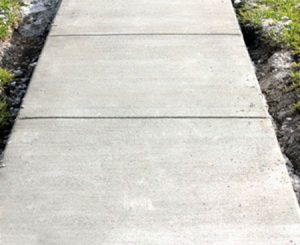 What are Concrete Sidewalks?
What are Concrete Sidewalks?
Concrete Sidewalks are 4″ or 6″ (depending on whether or not they also support vehicular traffic) thick concrete slabs formed and poured in square or rectangular flags. These flags tend to be 4-6′ wide and long, separated by expansion or control joints that allow for the natural growth and contraction of concrete due to heat and the elements. Sometimes sidewalks are reinforced with wire mesh for added tensile strength.
Why are Concrete Sidewalks Important?
Concrete Sidewalks are important because they form the majority of pedestrian walkways along parking lots and roadways. It is important that these walkways remain free of trip hazards and other liabilities at all time to ensure the safety of those who use them.
 How are Concrete Sidewalks Installed or Repaired?
How are Concrete Sidewalks Installed or Repaired?
If new Concrete Sidewalks are to be installed, the first step is determining the thickness of the new sidewalks, and excavating the area to the required depth.
The area is then properly compacted, and if necessary, additional limerock may be brought in to provide a suitable base.
Once the area is prepped for new concrete, forms are built in the requisite size for the new sidewalks, and at this time wire mesh may be installed if required for increased tensile strength.
The concrete is then poured into the forms and allowed to cure, or harden.
After the concrete has cured, the forms are stripped from the hardened sidewalks, control joints are cut where necessary, and the surface is finished with a wire broom to reduce slippage.
If existing Concrete Sidewalks are going to be repaired, the first step is determining what type of repairs are necessary.
Concrete Sidewalks can either be completely removed and replaced, or in some case, the edges can be ground down using a concrete grinder. In instances where the transitions between slabs are off by 1/2″ or less, concrete grinding is an economical solution to reducing the trip hazard created by the height differential between slabs.
If adjacent slabs are lifted or sunk more than 1/2″, or if there is significant cracking throughout the flag, then the best option is to remove and replace the section of sidewalk. The existing flag is removed and properly disposed of, and then the area is assessed for the cause of the damage. In many cases tree roots or vegetation have forced the flags to shift or caused cracking. In these instances, the roots are saw-cut and removed or ground down using a stump grinder. Additional limerock or compaction may be required to restore a reliable base, but once the area has been properly prepped, the new sidewalks are installed in the same manner described above.
